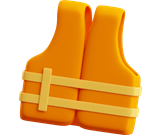Parents are likely to worry whenever their little ones are around water—and with good reason. Drowning is the second leading cause of death for children ages 1 to 4, according to the American Academy of Pediatrics (AAP).
That’s why the AAP recommends parents put layers of protection in place, during the summer months and throughout the year.
Put up barriers between your child and water, inside and out
You may have heard these warnings before, and they’re true:
- A toddler can drown in just inches of water.
- Pools are a particular risk for children, whether the pool is in your backyard or somewhere else.
Every pool should be surrounded by a fence at least four feet high on all four sides. That includes inflatable pools, above ground pools, and any other temporary pools. Keep the gate locked and check it frequently to make sure the lock is working.
If you have young children, remove or fence any other water hazards around your home, such as a bird bath, fountain, or pond. Empty or seal and put away buckets and other open containers including coolers, trash cans, and even large water bowls for pets.
Also, when children are young, block unsupervised access to bathrooms. Toddlers can easily fall into bathtubs or toilet bowls. Use safety latches, if needed, to keep bathroom doors closed, tub drains open, and toilet lids locked in place.
Provide close and constant supervision
When a child is near water, give them your undivided attention. Even looking away to respond to a text can be enough time for a child to tumble into water and drown. “Most child drownings inside the home occur in bathtubs, usually during a lapse in adult supervision,” says the AAP.
To make sure you’re close enough to your child and totally focused—whether it’s bath time or your child is swimming—think of keeping “in touch.” By touching your child in the water and keeping them within arms length, you stay ready to respond if needed.
While you may ask others to help you watch, don’t leave your child’s safety in the water up to someone else. Especially, do not ask an older child to keep watch over a toddler who’s in the water. Instead, remove the young child from the water and take the child with you.

Use life jackets near lakes, rivers and pools
Children and adults should always wear life jackets when on a boat. But children should wear life jackets when they’re near water, too.
Put your young child in a U.S. Coast Guard approved life jacket that fits properly. Have you child wear the life jacket all the time they’re near a river or lake, on a dock, around a pool, or at a water park.
Start swimming lessons as soon as your child is ready
Learning to swim is another layer of water safety, with studies showing that swim lessons can reduce the risk of drowning for all children, even very young ones. Look for lessons that help young children learn how to get out of the water if they fall in and other survival skills, as well as basic swimming.
Deciding how early a child should learn to swim depends on that child’s emotional maturity and physical development. Parents can talk with their pediatrician to determine if a child is ready to learn to swim.
The American Red Cross provides free online water safety instruction and can help you find in-person classes. You can also check with your local parks and recreation department or YMCA to find affordable and free swimming programs.

Teaching young children water safety can help make water play more enjoyable for all.
